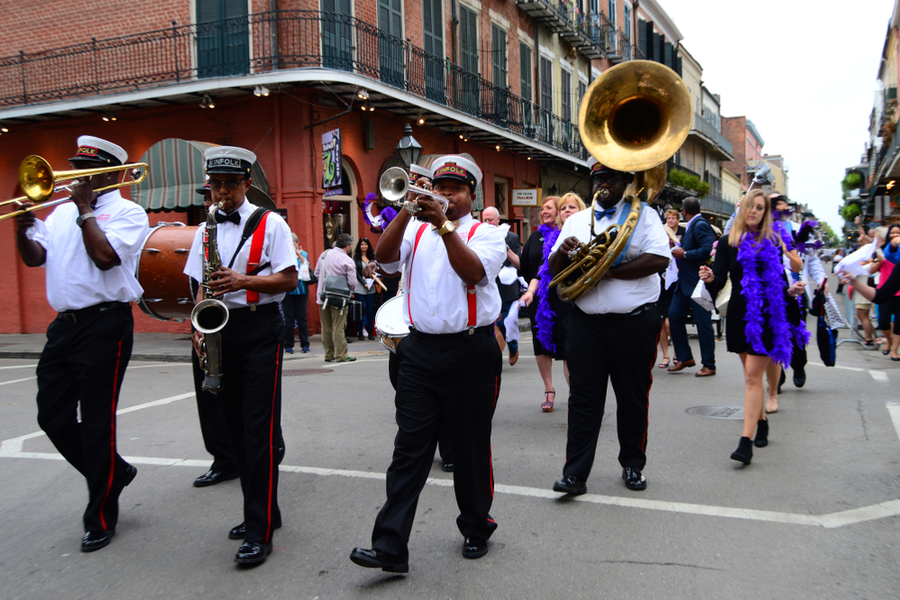
New Orleans Jazz Funeral
A New Orleans funeral procession is colloquially termed a Jazz Funeral, but the term was generally disdained by New Orleans natives up until the 20th century. They preferred the term “funeral with music”. This disdain has faded over the last 100 years, and now “Jazz Funeral” is considered acceptable.
A Jazz Funeral Procession
While the funeral procession is dressed in black, that is where the similarities between a New Orleans funeral procession and a traditional western funeral end. Most western funerals are somber affairs, with the most ostentatious part being the blinking lights of a police escort, if the deceased was an officer of the law. Other than roses tossed on the casket, or an elegant burial urn, and perhaps a haunting rendition of ‘Ave Maria’, the typical western funeral is a solemn and somber occasion.

This is not so in New Orleans. With entire streets blocked off, even the somber dirges being played on the way to the church are full of the life and energy of an entire marching brass band. Sunlight glints off wailing trombones, as musicians in black suit coats and white dress shirts play their way down the street. A tuba bell is emblazoned with black and white letters naming the deceased. Many are wearing stylish hats to keep the sun out of their eyes and tourists on either side of the street vie for a position to take pictures and videos. Members of the processional walk among the musicians carrying pictures of the person who passed on wooden pickets. The sound of the music can’t mute the sounds of conversations, singing, and even cheers as the funeral procession marches on.
Order of Ceremony
A New Orleans Jazz Funeral is extremely ritualized, and there is a strict order of events that must be followed. Generally, there is a wake before the funeral where family and friends of the deceased gather together. From the home where the wake is being hosted begins the marching procession to the church, where the family and friends are led by a brass band, often comprised of dozens of members, to the church where the funeral service is being held, playing funeral dirges, and other solemn music along the way. The group of people following the brass band is called the “second line”. The second line are not solemn marchers, they are marching, or moving the music, often creating their own grand display that complements the spectacle of the marching brass band. If this is a Christian funeral, mourners will often follow the biblical example of “rejoicing” at death, leading to a spirited display all around. While this may sound undignified, or wild, even the spirited rejoicing happens at specific moments that have been planned out through rituals dating back a hundred-plus years. When the procession reaches the church, they have a more traditional, somber western Christian funeral.
History and Roots of the Jazz Funeral
The Jazz Funeral is rooted in European and African cultural influences, in addition to the military influences based on Louisianans colonial past. The military influence can be seen in the brass bands since brass bands play at military funerals. These influences combined with African spiritual practices, specifically from the Yoruba tribe of Nigeria and other tribes from Western Africa. There is also a strong influence from the Catholic and Protestant churches of the early 20th century, which we see in the ritualized “rejoicing at death” part of the Jazz Funeral.
The Jazz Funeral was common in all ethnic communities during the late 1800s and at the beginning of the 20th century. As brass bands became more popular and wilder before World War One, many in the white community came to look at the Jazz Funeral with distaste and considered the spirited music to be disrespectful. It wasn’t until the 1960’s that the Jazz Funeral again became a more common practice across many religious and ethnic boundaries.
Jazz Funerals are Now Less Common
Similar to the rising rates of people opting to cremate their deceased loved ones, due to the lower cost of using a burial urn or a cremation urn, Jazz Funerals are becoming less common as well as people opt for simpler, less expensive ceremonies. The cost of pageantry and a full brass band far exceeds the cost of a regular funeral, even as funeral costs are rising. (Many people prefer cremation because it is less expensive to use a burial urn, if the remains are being buried, in addition to the flexibility offered by cremations. The remains can be kept in a place of honor in the family home in a display urn, or the ashes scattered using a unique urn, like an ice urn, or a water urn, both of which dissolve, releasing the ashes safely into the water.) However, despite the Jazz Funeral becoming less common in New Orleans, the practice of using brass band processionals has now spread to other parts of the country, and they remain very popular to this day.


